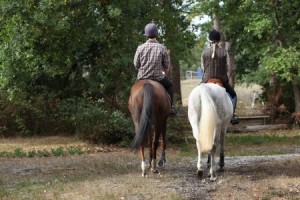The warm weather has finally arrived and of course you’re eager to start riding your horse again! Whether it’s going for a long, relaxing trail ride with friends or returning to the show arena to compete, for many of us summer is when we get to spend the most amount of time riding our horse. Along with long days and warm sunshine, summer can often include extended periods of uncomfortable heat waves and high humidity which can be dangerous for both you and your horse. When the temperatures start to soar, your horse can be at risk for sunburn, dehydration or even heat stress especially when he is exercising. So here are some summer horse care tips to help you safely get through the hot days ahead.
Water
Keeping your horse well hydrated at all times during the hot weather is extremely important, and summer horse care includes making sure that your horse has access to fresh water at all times. On average, a resting horse will drink 10 gallons of water per day, and when he’s working or when the weather heats up he might drink up to 25 gallons a day. Your horse will need to have free access to fresh, cool water (ideal temperature range is 45°F to 64°F), and his water buckets or water troughs need to be placed in shaded areas away from the sun so that the water can stay nice and cool. If his water is left out in the direct sun and gets hot, there’s a good chance that your horse will not want to drink it. As part of summer horse care, you’ll need to check the water levels in his buckets a few times each day and fill it if it’s getting low. If your horse is using an automatic waterer, you’ll need to check it daily to make sure it’s working properly. Your horse will need water that is clean and free of dirt or debris, and part of your daily routine should be to inspect and clean your water buckets especially during the summertime since bacteria and algae are more likely to grow during hot, humid conditions. If you’re not sure about the quality of the water that you’re giving to your horse, a good question to ask yourself is whether or not you would want to drink it. If the answer is yes, then you’re doing a great job providing quality drinking water for your horse!
Shade and Shelter
Providing your horse with shade and shelter is also very important during the hot summer months. If your horse is outside in a pasture (either full time or just for turn out sessions), he is going to need a place where he can escape from the sun. Your horses’ pasture will need to have a run-in shed (or several sheds if your horse is turned out with other horses) or several big, shady trees that will provide relief from the heat and the powerful rays of the summer sun. The run-in sheds should have tall roofs so that the air can easily circulate and effectively cool down the shed. Also, if you typically turn your horse out during the middle of the day, you’ll want to adjust his schedule so he’s turned out during the cooler hours such as early in the morning or later in the evening. If you keep your horse in a barn, be sure that it’s well ventilated by keeping the barn doors and windows open to encourage air flow. Additionally, you may want to put up cooling fans made especially for barns, or install a water misting system to help provide additional relief. Cooling fans, of course, should be set up in a safe area where your horse cannot reach the fan or the electrical cords. As an extra bonus, increased airflow and fans can also help control flies around horses since fans can discourage flies from hovering around your horse. You’ll also want to provide your horse with additional protection by using essential summer horse care products such as fly sheets, fly masks and fly repellent (try Equi-Garlic for a natural alternative).
Salt
All horses can benefit from access to free-choice salt, but it’s especially important during the summer months when your horse is sweating more either from additional exercise or from the hot, humid weather. The amount of salt that your horse needs will vary depending on your horse’s size, activity level and environment, but when any horse sweats he’s going to need to consume extra salt to help replace what he’s lost through sweat. Salt is available in a variety of forms, from small (four pound) blocks to 50 pound blocks that can be purchased at your local feed store. Some people like to use iodized salt blocks, while other people prefer to give their horse salt blocks that have added trace minerals that typically include zinc, manganese, iron, copper, cobalt and iodine. Another available choice is to feed loose salt, either with or without added minerals. Fortunately, most horses are able to self-regulate their salt intake so you can let your horse have free access to salt by placing it in a location that’s easy to reach either in his stall or in his pasture area. If you keep several horses together in a pasture, you’ll want to place several salt blocks in different locations so that your horses can have access to the salt blocks without being chased away by the others.
Limit Riding Activity
Another summer horse care tip to help combat the hot, humid weather is to alter your riding schedule. You might be accustomed to ride during the middle of the day, but this can be stressful to your horse, especially if he is older, overweight or not properly conditioned. To help escape the heat when you want to go riding, you can get up a little early and go for a morning ride, or you could wait until after the sun goes down and the temperatures are more comfortable for both you and your horse. Also, if you have access to a covered arena, you can ride inside where it’s cooler and there is plenty of shade. If you’re riding in an uncovered area, make sure you go slower and give your horse plenty of breaks so he can rest. Horses have a hard time regulating their body temperatures when the heat exceeds 90 degrees; and if you are in an area where there is also high humidity, your horse will have a hard time exercising in temperatures much lower than 90 degrees. To keep up with the current weather, forecasts and heat index in your area, visit the University of Kentucky’s Weather Center (just enter in the zip code for your area). After you’re done riding, spend some time hosing and sponging off your horse with cool water. This will not only help cool him down, but it’ll feel so refreshing as well! Use a sweat scraper to remove the excess water, and let him dry outside in the shade. You’ll want to avoid putting him back in his stall when he’s wet, as this could cause him to overheat due to the hot temperatures and the confined space.
Trailering
You might be trailering your horse more frequently during the summertime, especially if you compete and are regularly going to horse shows. Riding in a trailer can be tiring for your horse as he constantly has to work trying to balance himself, and traveling during hot, humid conditions can easily leave your horse fatigued by the end of the ride. You can help minimize the stress on your horse by leaving early in the morning so you’re not traveling during the hottest part of the day (plus you’re more likely to avoid traffic if you leave early which will be less stressful for you, too). Before you load your horse into the trailer, open the windows and ceiling roof vents in advance so that your trailer has a chance to cool down. Also, pack your trailer with all the supplies and tack that you’re going to take with you before you load your horse into the trailer. Once you’re all organized and ready to head off on your trip, you can then load your horse so he’s not waiting unnecessarily in the trailer while you’re wrapping up loose ends. During your travel, you’ll want to keep the windows and vents open for cross ventilation but make sure the windows have protective screens on them to help prevent your horse from injuring his eyes either from bugs or flying road debris. You’ll want to bring along plenty of drinking water for your horse, and regularly stop to offer him water and to take rest breaks. When you pull over for your rest stops, find a shady location to park so that your trailer can stay cool while your horse is resting.
Senior Care
Just like older people, many senior horses can be sensitive to hot weather conditions and high humidity. It’s much harder for senior horses to keep themselves cool and regulate their internal temperatures, so if you have a senior horse, you’ll need to give him some extra care during the summer. It’s important to be very cautious when exercising a senior horse in the heat – he’s not going to be able to work as hard or as long as his younger counterparts. Older horses might not show signs of fatigue or overheating in the early stages, so keep a close eye on your horse while you’re riding him, take it easy, and give him frequent rest breaks. In terms of housing, your senior horse will need adequate shelter to escape from the hot sun, and his stall should be well ventilated and have a layer of shavings so he has a soft place to rest. You’ll need to clip your senior horse if he has a long coat (such as a horse with Cushing’s disease), being careful that you don’t clip too close since exposed skin can easily sunburn. Horses with Cushing’s disease also have a difficult time regulating their body temperature, so if your horse has Cushing’s disease, you’ll need to monitor him very closely in the summertime. Insect control and fly protection is also an important part of taking care of your senior horse in the summer. While flies are annoying to all horses, senior horses seem especially bothered by flies and other biting insects and they may not want to swish their tails or stomp their feet like the younger horses will. Your senior horse will greatly appreciate the relief provided by fly sheets, fly masks and other fly control products.
So by thinking ahead and planning on how to take care of your horse during the summer, you can help keep your horse (and yourself) comfortable and cool during the hot days ahead. What plans do you have to help keep you and your horse cool in the summer?









brooklyn says
this was very helpful as im looking into buying an older horse